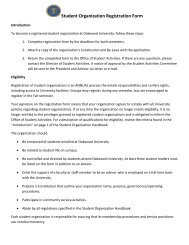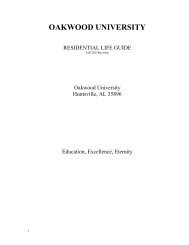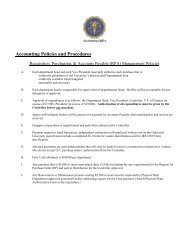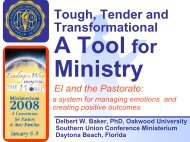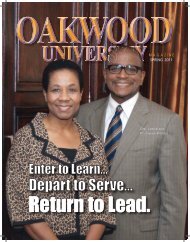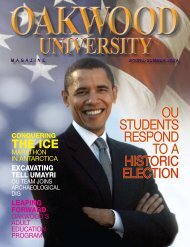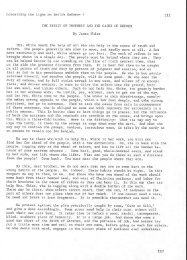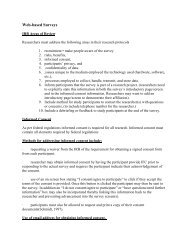Budget Management Presentation 2012 - Oakwood University
Budget Management Presentation 2012 - Oakwood University
Budget Management Presentation 2012 - Oakwood University
- No tags were found...
Create successful ePaper yourself
Turn your PDF publications into a flip-book with our unique Google optimized e-Paper software.
• ALL OF THE FOLLOWINGINFORMATION HAS BEENCOMPILED (EDITED OR SHORTENTO FIT FOR PRESENTATION ANDTIME RESTRAINTS) FROM THE OUPOLICY MANUAL LOCATED ON OUWEBPAGE.
<strong>Oakwood</strong> <strong>University</strong>Gail Caldwell and Trevor JohnsonAugust 1 & 2, <strong>2012</strong>
PURPOSE STATEMENT:To support quality Christian education byproviding students, staff, faculty, vendors,board members or out-side sources withefficient service and accurate financial data in atimely manner for administrative decisionmaking or reporting.
• Policy or Procedures are guided by thefollowing requiring entities:• FASB –Financial Accounting Standards Board-GAAP –Generally Accepted Accounting Principles• GASB –FAR – A-133 Requirement• IRS• NAD Auditing Standards• OU Board of Trustees• OU President’s Council• OU Accounting Internal Control
Accounting DepartmentWho’s doing what?Gail Caldwell, Controllergcaldwell@oakwood.edu-Approves all incoming purchase requisitionsand campus leave forms-Approves budget transfers and all payrolladjustments, etc.-Handle all questions related to budgetmanagement.-Financial Surveys-Add New AccountsTrevor Johnson, Chief Accountanttrjohnson@oakwood.edu-Accounts for all financial recording-Approve all journal and invoices-Financial Reporting-Update <strong>Budget</strong> Transfer-Account/<strong>Budget</strong> QueryLaketia Chapman, Jr. Accountant – A/Plchapman@oakwood.edu-Process all checks (including Federal and A/P)-Log, Mail & File All Checks-Void, reprocess, or back-out invoice-Input InvoicesCompton Brathwaite, StaffAccountantbrathwaite@oakwood.edu-Title IV process & reconciliation-Salary, Fringe recovery of Federal grants-Federal Cash receipts (Fed, Marc, & Restr.)-Fixed Assets CustodianCheryl Sullivan, Payroll Managercsullivan@oakwood.edu-Payroll Custodian-W-2
-Kerry Joseph, Federal Accountantkjoseph@oakwood.edu-Verify all federal requisitions (includingcampus leaves)-Process Federal Travel Reports-Federal, Grants & Contracts questions-Federal Quarterly reports-Federal Reconciliations, Title IIIColesh Thompkins (Temporary), Jr.Accountant- A/P@oakwood.edu-Process all PO invoices (except Physical Plantand Library Dept),-Sales Tax-AMEX,-Add Vendors-1099Deborah Taylor, General Accountantdtaylor@oakwood.edu-Interdepartmental Charges-Journal entries, Account corrections-GC, OC Academy and White Estates invoices-G/L Permission and Approver Set-up-Bank Wires, Stop-payment, Banking (General)-Deferred Charges & Recurring chargesDoris Collie, Staff Accountantdcollie@oakwood.edu-Process utilities, contracts or lease-Process PO invoices for Physical Plant andLibrary-Payroll Assistance-Process all employee’s time
Cecil Spence, Staff Accountantcspence@oakwood.edu-Payroll Deduction Invoices and payments-Other Bank Reconciliations-Quarterly 941 ReportingChris McNish, Clerk/Help Deskcmcnish@oakwood.edu-Process all requisitions to invoices-Distribute checks-Travel and Cash advance payment Custodian-Requisition Help desk and Trainer-Add new Vendors (from W-9 Form, only)
• <strong>Budget</strong> Policy and Control• Travel• RPA• General Accounting Procedures• Money Collection• Petty Cash• Gift Cards
BUDGETING PROCESS
The <strong>Oakwood</strong> <strong>University</strong> fiscal year runs fromJuly 1 to June 30, and an annual budget isdeveloped which clearly identifies income andexpenses. Each cost center follows a budgetingprocess which allows input from faculty andstaff.
The following timetables are used in developing the <strong>University</strong> budget.1. October: <strong>Budget</strong> assumptions are determined by the President and the Vice Presidentfor Financial Affairs and presented to the President’s Council for approval andsubsequently presented to the Finance Committee and the Board of Trustees forapproval at their October/November meeting. <strong>Budget</strong> assumptions categories areas follows:• Number of full-time enrolled students• Dormitory capacities and rates• Tuition rates• Board rates• Cost-of-living increases for salaries (as voted by the NAD at year-end meetings)• Travel allowances (as voted by the NAD at year-end meetings)2. December 15: The Vice President for Financial Affairs initiates the budgeting processby sending salary information to each administrative officer separated by costcenter (department). The salary information consists of the present pay rate,proposed pay rates based on the cost-of-living increase voted by the Board ofTrustees at its fall meeting, and the proposed annual salary amount based on theproposed pay rates. Department directors are asked to review this data andsubmit freezes and/or additional staff with supporting documentation.
3. January 15: Administrative officers return the salary data to the Vice President forFinancial Affairs for review by the President.4. January 31: A budget worksheet is distributed to the administrative officers for theirrespective departments. Limits to use for increases in general expenses.Any other information or instruction which would be required by department directorsto develop budgets5. February 28: Department directors are to obtain input from their staffs and use thedata provided to prepare a budget proposal by line item to their administrativeofficer in time for submission to the Vice President for Financial Affairs by thisdate. The administrative officers determine their process for involvement indevelopment of their respective departmental budget proposals.6. March: The President and the Vice President for Financial Affairs meet with eachadministrative officer during the month of March to review, evaluate, andnegotiate his/her proposed budgets. Department directors may be requested tomeet along with their administrative officer to provide additional information asneeded.
7. March 31: A final balanced budget is completed forpresentation to the Finance Committee and the Boardof Trustees. Preparations are made for faculty and staffcontracts, subject to final approval by the Board ofTrustees.8. April: A final budget is presented to the Board ofTrustees for approval.9. The Vice President for Financial Affairs presents thecurrent financial position, with comparisons of actionpertaining to the budget.10. Employment contracts for faculty and staff areprepared and ready for distribution by June 1.
BUDGET REPORTS ANDCONTROL
1. Reports are available to department directors generally by the fifteenth of thefollowing month. Department directors develop and follow their own budgetreview process. (Available on EX Jenzebar or My<strong>Oakwood</strong>)2. A report of negative budget variances is to be prepared by each departmentdirector and submitted to their respective administrative officer by the twentieth ofthe following month for review and approval. The report of negative budgetvariances requires determination of the reason for and corrective action of thenegative variance. (See Example available on-line Accounting Website)3. Administrative officers are to submit a report of negative budget variances fortheir division to the Vice President for Financial Affairs by the twenty-fifth of thefollowing month.4. The Vice President for Financial Affairs is to submit a summary report of negativebudget variances for all divisions to the President by the thirtieth of the followingmonth.
5. The Vice President for Financial Affairs gives a financial report to the President’sCouncil on its last meeting of each month (generally the fourth Wednesday).6. The Vice President for Financial Affairs gives a financial report to the facultyduring their business meeting once each quarter.7. The Vice President for Financial Affairs presents the current financial position,with comparisons of actual amounts and budgeted amounts, at each executivecommittee, finance committee, and Board of Trustees’ meeting throughout theyear.
My<strong>Oakwood</strong> <strong>Budget</strong> DemoNegative Variance Sample(Instructions on Accounting Web Page)<strong>Budget</strong> Transfers(Located on Other Transactions Form)
It is the policy of the <strong>Oakwood</strong> <strong>University</strong> toreimburse employees who travel at the requestof the <strong>University</strong> for reasonable and necessaryexpenses incurred while traveling onauthorized <strong>University</strong> business.
Travel AuthorizationA. Travel Authorization. A TravelAuthorization form (Campus Leave) is requiredfor all reimbursable travel including institutionand grant travel.The Campus Leave form is completed before theTrip is taken and before travel arrangements arefinalized.(See instructions for creating a CampusLeave/Expense Report in EX)
B. Expense ReportsGeneral steps for turning in travel reports:1. Travel reports are due in the Accounting Office within seven working days following anemployee's trip. Retrieve report from the Accounting Report Form Menu on Webpage.2. Travel reports should be filled out completely and all original receipts should be attached.Attach on-line to requisition when applicable for reimbursement.3. Travel reports should not be turned in without the following signatures or it will result ina delay on reimbursements: employee, department head, and division head. To expeditethe reimbursement, create a requisition for a check (CK) for the amount of thereimbursement from the travel report.4. Employees should allow a week to ten days for any reimbursements (due to the volumeof reports being submitted).5. Any reimbursement to the school must be paid and receipted with the cashier, and theoriginal receipt should be attached to the travel report before submitting to theAccounting Distribution Office. No money should be turned into Distribution Center atany time.
C. Per Diem. The per diem includes all charges for meals, gratuities torestaurant employees, and laundry where allowable. The current perdiem regulations are:*Per diem is $41* No per diem allowance will be paid for a trip of less than six hours.* For a trip greater than six hours but less than twenty three hours, a mealallowance of $20.50 (receipts are required) will be paid.* For an overnight trip, $41 per day will be paid.* When all meals are provided by others (persons or organizations) perdiem is $13.00 (fully entertained)* Pre-authorized (by Vice President) Family per diem is $57.00If an employee does not wish to receive the per diem (in full or partial)he/she must state in writing that they voluntarily forfeit the per diem duethem.
D. Privately Owned Vehicles. Mileage in lieu of actual transportation expenses may bereimbursed per mile at the rate of $.39 per mile.E. Receipts. Receipts should be obtained whenever possible for any travel expenses, but arerequired for all registration fees, air fare, rail and bus fare, gasoline and oil purchases for rentalvehicles, and for any other expense greater than $10. If car rental and gas receipts are lost fortrips where the rented car was driven for more than 60 miles, then the mileage rate may (withUnit VP=s and Financial VP=s approval) be claimed in lieu of rental reimbursement.F. Early Departure or Late Returns. A memo is required to justify an employee leaving on anearly travel date or returning late. The justification should document the reduction in the totaltravel costs.G. Hotel Expenses. Hotel expenses should be broken down on a per-day basis. The amountshould include the room charge plus any applicable room taxes and should not include anytelephone, meal, or parking expenses. The <strong>University</strong> does not reimburse expenses for movierentals. If two employees share a hotel room, each employee should record 2 of the cost onhis/her travel report. The employee who paid for the room should attach the original receiptto his/her travel report. The other employee should attach a copy of the hotel receipt with anexplanation that a room was shared and that the original receipt is with the other employee'stravel report. If a non-employee shares a room, the employee will be reimbursed for the singleroom rate only.
H. Air, Rail or Bus Fares. Tickets purchased by the individual cannot be reimbursed until the tripis completed. A receipt from the airline (versus a credit card slip) is required.I. Other Allowable Expenses. The following are allowed for reimbursement:* Baggage charges for baggage in excess of the weight carried free bycommon carriers are allowable if such excess is used exclusively for officialbusiness. Storage and handling charges may also be allowed under the sameconditions.* Gratuities. Tips to taxi drivers, and/or housekeepers are allowablewhen deemed by administration to be reasonable and necessary. Gratuitiesclaimed as travel expenses should be consistent with levels generally accepted,taking into account geographical location, types of services provided, and anyspecial circumstances. (limit $20.00 per trip)* Porterage. Reasonable expenses for baggage handling services are allowablefor delivery to or from a common carrier and delivery to or from a lodgingaccommodation. (limit $20.00 per trip)
Other Allowable Expenses, con’t.* Registration Fees. The payment of registration fees, which are required as admittancefees for participation in meetings are allowable. Meals included as part of theregistration fee may not be claimed separately. Organizational membership dues, asdistinguished from registration fees, shall not be processed for payment as travel.* Telephone and Facsimile. Expenses for necessary official telephone and facsimile servicesare allowable. Whenever possible, telephone calls to an activity's central office shall bemade by direct dial. (limit $20.00 per trip)* Airport parking for Huntsville Airport is reimbursed up to the rate of $8.00 per day for amaximum of $50.00 per trip.* Hotel parking is reimbursed up to the rate of $30.00 per day for a maximum of $210.00 pertrip.
J. Non-Allowable Expenses for Travel. The following (not allinclusive) are not allowed for reimbursement:* Miscellaneous supplies* Alcoholic beverages* Personal phone calls* Unauthorized entertainment and hospitality expenses* Items without receipts* Unauthorized spending (books, gifts, etc.)* Payment of mileage rate when renting a car (If you drive a car, youcan receive either the mileage rate or reimbursement for gas, not both.If you rent a car, the original receipt for gas and car rental should beturned in for reimbursement only.)* Items that are not included on the Campus Leave form.* Unauthorized trips
Requisition, Purchasing, & Accounts Payable (RPA) <strong>Management</strong> PoliciesEach department head and each Vice President must duly authorize each purchase thatis:-within the guidelines of our <strong>University</strong>’s mission and Departmental plan-within the available funds budgeted-reasonable and necessaryB. Each department head is responsible for supervision of departmental funds.He/She will be accountable for any delegation of approval.C. Approval of expenditures is as follows: the Department Head, Vice President,Controller, V.P. of Finance (in excess of $7,500), President (in excess of $10,000).Authorization of all expenditures must be given by the Controller before anypurchase.D. Approved Purchased Orders will be process for payment by Accounts Payable whenmerchandise and invoice are received.
Requisition, Purchasing, & Accounts Payable (RPA) <strong>Management</strong> Policies,con’t.F. Payment request to small businesses, independent contractors/self-employedworkers not on the <strong>Oakwood</strong> <strong>University</strong> payroll must include a completed W-9form for vendor identification and for IRS 1099 Form specification.G. Advance payments are cash disbursements that will only be made for travel,construction contractors or vendors who do not accept O.C. purchase orders;authorization from the Controller.H. Petty Cash allotment is $100.00 per department.I. Any purchase that is $5,000 or more must attach three (3) bids (including the onerequisitioned) to the Request for Purchase Order (RP) and sent to Distribution forthe Controller Approval.J. Any Renovations or Maintenance projects costing $2,500 or more must beinspected by Physical Plant Department (approved personnel) before submittingrequest for the Final payment. (Attach Physical Plant Authorization Form to therequisition.)
RPA PROCEDURESLocated in Financial Affairs Policy Manual and onAccounting Web Page
General Accounting transaction will follow the same Approval process as RPA, but it will beprocess on an "Other Transaction Form" and not On-line.Additional Compensation for <strong>Oakwood</strong> staff, faculty or student, of any amount, must be processusing the HR - “Personnel Requisition”- for faculty and staff or OSE- “Work Contract” for student.Payment will be combined with the payee’s payroll check. All student payments must be processthrough Office of Student Employment.<strong>Budget</strong> Transfers are processed using the “Other Transaction” Form. Accounting will create budgettransfers, monthly. If the transfer is made between two (2) different funds (01 to 02, 02 to 06, etc.)then a “Requisition for Check” should be created for process and approval.Departmental charges must be posted on a monthly basis. This information should be received inthe Accounting Office on the twentieth (20) of the month. Each charge must be supported by anappropriate document (e.g., meter reading, telephone bills, etc.). Departments submittinginterdepartmental charges are: Campus Communication, Computer Center, Graphix, Mailroom,Physical Plant, Transportation.Interdepartmental purchases or transactions are services rendered by O.C. department for anotherO.C. department. The department that receives the service will complete the "Other Transaction"form. Minimum information needed: Department, date, account to charge and account number torecord revenue, amount, signatures and supporting document for transaction.
Miscellaneous request such as duplicating charges, accountadjustments or corrections or other JE must complete “OtherTransaction” Form located at Purchasing.Petty Cash allotment is $100.00. Complete “Other Transactions”Form with account number, amount, signatures and descriptionof purchases; drop-off original at Accounting Distribution. Pinkcopy will be returned to Department after Controller approval.Bring pink copy to Cashier for Petty Cash. Original receipts orinvoices are returned to the Petty Cash custodian within five (5)business days of purchase. No petty cash is issued todepartments with outstanding receipts. Petty cashpurchases/requisitions not authorized or approved are personalpurchases.Do not use Petty Cash funds to compensate any person forservices, gift or appreciation.
Strong internal controls for money collectionare necessary to prevent mishandling of<strong>University</strong> funds and are designed tosafeguard and protect employees frominappropriate charges of mishandling funds bydefining their responsibilities in the cashhandling process.
Guidelines for Establishment:A cash collection point is defined as a department orother entity that handles cash on a regular basis.Casual cash collections are not recognized as cashcollection points, they must follow the same cashhandling policies and procedures that apply to the cashcollection points.Cash collection points requires the Approval by theVice President of Financial Affairs (See list ofrequirements to be included)
Required procedures for cash collection points include thefollowing:Accounting for cash as it is received.Adequate separation of duties which includes money collecting,depositing and reconciling.Proper pre-numbered receipts given for any money received.Approval of any voided money receipts by departmentchair/director.Deposit of money promptly at the <strong>University</strong> Bursar’s Office intoan authorized <strong>University</strong> account..Reconciliation of validated Receipt Transmittal Forms tosupporting documentation and to the account summary in EXApproval by the Vice President for Financial Affairs of anychanges in money handling procedures.Proper safeguarding of money.
Depositing Money Collected• A calculator tape of the checks should be included withthe checks bundled together.• The appropriate account number(s) and sub-code(s)must be included on the Receipt Transmittal Form.• Someone not involved with collecting the cash,opening the mail or reconciling the deposit mustprepare the deposit.• The deposit must be delivered to the Bursar’s Office.(Sample Cash Daily Tally)
ExceptionsThe Controller’s Office must approve exceptionsto these procedures. For example, in caseswhere there is not enough staff available tomaintain complete separation of duties, analternate process to safeguard <strong>University</strong> fundsmust be established and approved by theController’s Office. Requests for exceptions tothese procedures must be submitted to theController’s Office in writing.
Petty Cash allotment is $100.00. Complete “OtherTransactions” Form with account number, amount,signatures and description of purchases then drop-offoriginal at Accounting Distribution. Pink copy will bereturned to Department after Controller approval. Bringpink copy to Cashier for petty cash. Original receipts orinvoices are returned to the petty cash custodian within five(5) business days of purchase. No petty cash is issued todepartments with outstanding receipts. Petty cashpurchases/requisitions not authorized or approved arepersonal purchases.Do not use Petty Cash funds to compensate anyperson for services, gift or appreciation.
Gift cards/gift certificates may not exceed Twenty-fivedollars ($25), unless approved by the President and/or theunit Vice President.Gift cards/gift certificates may be purchased for awards orrecognition programs such as retirement events, employeerecognition events, birthdays, holidays, anniversaries,length of service, and other events as determined by thePresident and/or unit Vice President.Purchased gift cards/certificates should generally not beconvertible to cash (this would probably eliminate - Amex,Visa, Walmart, MC, Discover, etc.).
No federal or state funds may be used topurchase gift cards/certificates.Gift cards/gift certificates may not be used as aform of honoraria for employees. Gift cardsshould not be used to reward past or futureperformance. These types of payments mustbe processed through the payroll system.
A signed "Authorization (Purchase Order) for thePurchase of Gift Cards/Gift Certificates" is requiredPRIOR to purchasing gift cards or certificates. Thisauthorization is for a single intended purpose only –(i.e.: a specific study, a specific event, etc.) and must bespecified in the "Detailed Description of IntendedPurpose for Items Purchased" section on the form. It isrecommended to limit the number of gift cardspurchased at one time so that the disbursementdocumentation is more manageable. If the originalintended purpose or intended vendor changes, a newauthorization form must be completed.(See Policy for the included information on therequisition)
• Departmental Documentation1. Proof of original purchase and authorizationform must be kept on file with the appropriatemethod of payment. The receipt must show theindividual gift card numbers purchased.2. A Gift Card/Gift Certificate Disbursement Logis required to record the dispensing of all gift cardspurchased - even if only one card is purchased forone individual. Instructions for maintaining thelog are as follows: (See Policy Manual orAccounting Webpage for details)Gift Disbursement Log Example
HANDOUTSQUESTION AND ANSWERING
• http://www.oakwood.edu/academics/institutional-effectiveness/administrative-policymanual• Accounting Office Webpage





